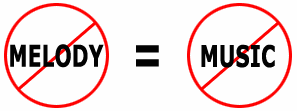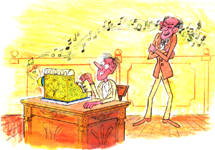 Melody,
harmony and rhythm are the elements of songs in Western music, as opposed
to Eastern, tribal, or other forms of music. A song in Western music will
have a key, and some songs may change keys (modulate), but most remain in
the same key from beginning to end. Melody,
harmony and rhythm are the elements of songs in Western music, as opposed
to Eastern, tribal, or other forms of music. A song in Western music will
have a key, and some songs may change keys (modulate), but most remain in
the same key from beginning to end.
Some sound compositions may consist of various natural
sounds (waves breaking, crickets, etc.), industrial sounds (jackhammer,
cash register, etc.) or percussion instruments which form rhythm patterns,
but rhythm without melody and harmony does NOT qualify as Western music.
A shopkeeper might consider cash register sounds to be "music to my ears,"
but it does not qualify as Western music.
 A
monotone chant set against rhythm does NOT qualify as Western music. Poetry
delivered in monotone to a percussion track may be "rap," but unless the
track also contains melody and harmony, it is not music as traditionally
defined in the Western world. It is pure rap as opposed to rap music. A
monotone chant set against rhythm does NOT qualify as Western music. Poetry
delivered in monotone to a percussion track may be "rap," but unless the
track also contains melody and harmony, it is not music as traditionally
defined in the Western world. It is pure rap as opposed to rap music.
If the monotone is consistent, or if the percussion has been tuned, such
sound compositions may present a pseudo-key which may prove useful in harmonic
mixing. Much of the recent rap listed in our database has been "keyed" in
this manner. Many rap songs, however, contain random samples completely
out of tune with the primary song elements. Harmonic mixing of these selections
is normally not worth the trouble.
Two rap styles are consistently musical and usually can be readily keyed.
West Coast rap (Death Row Records, Oakland sound, etc.) and "Miami Bass"
music, as well as obviously musical hip-hop containing singing (Bone Thugs,
TLC, etc.) are great candidates for harmonic mixing. Much of the Wu Tang
Clan production, on the other hand, is not melodic and keys are only approximate.
Music theory: Which Keys are compatible?
There are twelve major keys and twelve minor keys in which Western music
is written. Of the 24 possible keys, only six keys are compatible with any
given key. This means that only 25% (6/24) of all possible choices are harmonically
compatible. A beat-mixing DJ would have to test three melody overlays to
find one which is harmonically compatible. Three-fourths of this time is
wasted.
A mix would have perfect harmony when mixed with only
four keys, and reasonable harmony when mixed with two more keys. Using the
Harmonic Keys chart,
you will see that the four perfect harmony keys from any key are the Tonic
(same key songs), Perfect Fourth, Perfect Fifth, and Relative Minor. The
"reasonable harmony" choices are the Relative Major/Minor of the Perfect
Fourth and Perfect Fifth. Thousands of DJ's mixed harmonically using this
Harmonic Keys system in the 1980's. It is now obsolete.
|